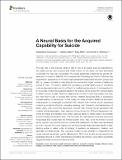| dc.contributor.author | Deshpande, Gopikrishna | en_US |
| dc.contributor.author | Baxi, Madhura | en_US |
| dc.contributor.author | Witte, Tracy | en_US |
| dc.contributor.author | Robinson, Jennifer L. | en_US |
| dc.date.accessioned | 2016-10-11T20:26:23Z | |
| dc.date.issued | 2016 | en_US |
| dc.identifier.citation | Deshpande, Gopikrishna, Madhura Baxi, Tracy Witte, and Jennifer L. Robinson. 2016. “A Neural Basis for the Acquired Capability for Suicide.” Frontiers in Psychiatry 7 (1): 125. doi:10.3389/fpsyt.2016.00125. http://dx.doi.org/10.3389/fpsyt.2016.00125. | en |
| dc.identifier.issn | 1664-0640 | en |
| dc.identifier.uri | http://nrs.harvard.edu/urn-3:HUL.InstRepos:29002481 | |
| dc.description.abstract | The high rate of fatal suicidal behavior (SB) in men is an urgent issue as highlighted in the public eye via news sources and media outlets. In this study, we have attempted to address this issue and understand the neural substrates underlying the gender differences in the rate of fatal SB. The Interpersonal–Psychological Theory of Suicide has proposed an explanation for the seemingly paradoxical relationship between gender and SB, i.e., greater non-fatal suicide attempts by women but higher number of deaths by suicide in men. This theory states that possessing suicidal desire (due to conditions such as depression) alone is not sufficient for a lethal suicide attempt. It is imperative for an individual to have the acquired capability for suicide (ACS) along with suicidal desire in order to die by suicide. Therefore, higher levels of ACS in men may explain why men are more likely to die by suicide than women, despite being less likely to experience suicidal ideation or depression. In this study, we used activation likelihood estimation meta-analysis to investigate a potential ACS network that involves neural substrates underlying emotional stoicism, sensation-seeking, pain tolerance, and fearlessness of death, along with a potential depression network that involves neural substrates that underlie clinical depression. Brain regions commonly found in ACS and depression networks for males and females were further used as seeds to obtain regions functionally and structurally connected to them. We found that the male-specific networks were more widespread and diverse than the female-specific ones. Also, while the former involved motor regions, such as the premotor cortex and cerebellum, the latter was dominated by limbic regions. This may support the fact that suicidal desire generally leads to fatal/decisive action in males, while, in females, it manifests as depression, ideation, and generally non-fatal actions. The proposed model is a first attempt to characterize the neural networks underlying gender differences in SB. Future studies should examine the proposed network to better characterize and refine this network using tasks specifically targeted toward constructs underlying ACS. | en |
| dc.language.iso | en_US | en |
| dc.publisher | Frontiers Media S.A. | en |
| dc.relation.isversionof | doi:10.3389/fpsyt.2016.00125 | en |
| dc.relation.hasversion | http://www.ncbi.nlm.nih.gov/pmc/articles/PMC4970564/pdf/ | en |
| dash.license | LAA | en_US |
| dc.subject | suicide | en |
| dc.subject | depression | en |
| dc.subject | gender difference | en |
| dc.subject | functional magnetic resonance imaging | en |
| dc.subject | diffusion tensor imaging | en |
| dc.subject | meta-analysis | en |
| dc.subject | meta-analytic functional connectivity | en |
| dc.subject | structural connectivity | en |
| dc.title | A Neural Basis for the Acquired Capability for Suicide | en |
| dc.type | Journal Article | en_US |
| dc.description.version | Version of Record | en |
| dc.relation.journal | Frontiers in Psychiatry | en |
| dc.date.available | 2016-10-11T20:26:23Z | |
| dc.identifier.doi | 10.3389/fpsyt.2016.00125 | * |


